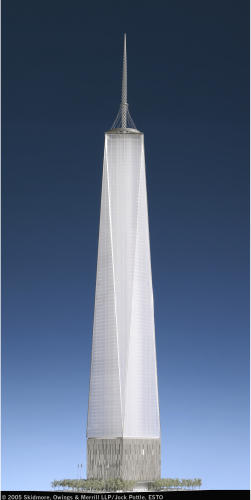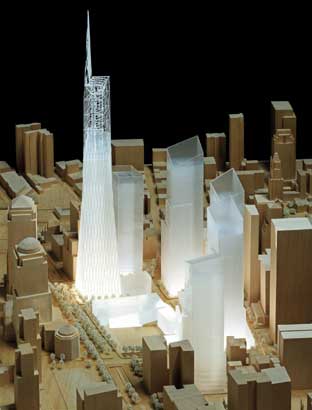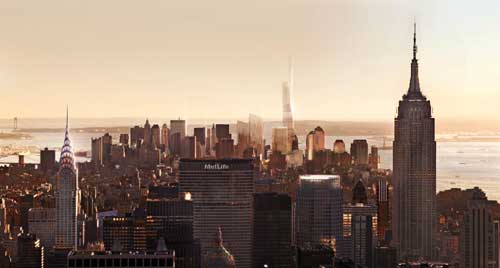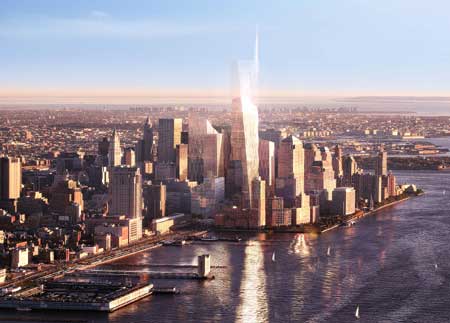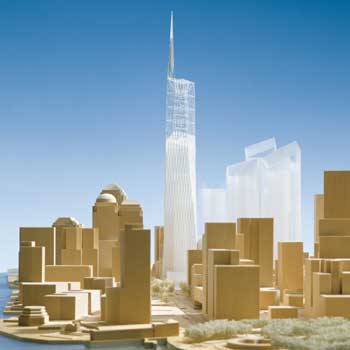World's Tallest - of COURSE!
The Freedom Tower: "An Alienating Monument to Surrender"The City of New York is like an enormous citadel, a modern Carcassonne. - Henry V Miller
The redesigned Freedom Tower, viewed from the southwest. by Jeff B Speck As a registered city planner and current Design Director at the National Endowment for the Arts, I would like to publicly address the latest redesign of the Freedom Tower [unveiled 29 June 2005]. I am writing this as a private citizen, however, and not in my official capacity. Never in my most pessimistic imaginings could I have anticipated what we are now being shown: a tower rising above a solid concrete base with no windows. News reports claim this 20-story, above-ground base will be clad in a "shimmering metal curtain that will give the impression of movement and light." The operative word in that phrase is "impression." The first rule of planning for pedestrians is "eyes on the street": windows and doors connecting inside and out. No one will happily walk past a blank wall, no matter how much it shimmers. This is one of the main tenets of urban design taught to all of the mayors who attend the NEA's Mayor's Institute on City Design. It is undisputed. That a proven design failure is being proposed for such a prominent site only confirms how far from reason the security mandate has taken us. There are many more subtle and sophisticated ways to provide bomb-blast security. The Freedom Tower's talented architects know them. One solution would be to line the blast walls with external lobbies or shops facing the sidewalk. Such alternatives must be discussed publicly, and quickly, so that we can turn away from this dead-end path. We must ask ourselves what it says about our nation to produce a "Freedom Tower" hiding behind 20 stories of solid concrete. Better to build nothing than such an alienating monument to surrender. Winston Churchill said that "the American people can be counted on to do the right thing, after they have exhausted all the alternatives." It is time to eliminate this exhausted alternative from the discussion. Jeff B Speck has been the Design Director at the NEA since 2003. Beforehand, he served as the director of town planning at Duany Plater-Zyberk & Company. Source: www.metropolismag.com Urban Journal | Talk2Us 5 July 2005 photo credit SOM
Ugly, ugly, ugly.
Twisting Skyscraper to Replace New York's World Trade Center
Freedom Tower - night view by Grant McCool A twisting, shimmering, glass-encased skyscraper topped by a spire evocative of the Statue of Liberty, will replace the destroyed World Trade Center towers, officials said on Friday after months of heated argument between architects over the design. The building dubbed the "Freedom Tower" will be the world's tallest at 1,776 feet when it is completed by the end of 2008 and is intended to reclaim part of Manhattan's famous skyline shattered in the 11 September 2001 attacks. "We will build it to show the world that freedom will always triumph over terror and that we will face the 21st century with confidence," said New York Governor George Pataki, who has final authority over what is built on the 16-acre (6.4 hectare) site in lower Manhattan's financial district. The tower will overtake Taipei 101 office block in Taiwan as the building regarded as the world's tallest. The Taipei building has not yet been completed but reached its maximum height of 1,667 feet in October. New York's new tower will contain some similar elements to the original twin towers that stood at 1,368 feet, including the restoration of the well-known "Windows on the World" restaurant and an observation deck. But the architects said it would be much safer and more environmentally sensitive. The entire project, with a memorial to the 2,752 victims at its centre, was estimated to cost up to $12 billion over the next decade, officials said. It also includes six other office buildings and a transportation hub to be designed by renowned Spanish architect Santiago Calatrava. The plan and model of the building, unveiled at a public ceremony on Wall Street, calls for 60 occupied stories, including 2.6 million square feet of office space, rooftop restaurants, and the viewing floor up to a height of 1,100 feet. The space above reaching to 1,500 feet will contain a lacy structure of tension cables similar to those on the Brooklyn Bridge and wind-harvesting turbines to provide 20% of the building's energy, the architects said. A spire, symbolic of the Statue of Liberty's arm holding up a flaming torch, will rise a further 276 feet to 1,776 feet - the height architect and site master planner Daniel Libeskind chose to represent the date of US independence when he released his initial plan a year ago. Libeskind described the spire at the top emitting a light into the sky at night, as one that would provide "a beacon of light and hope in a world that is often dark." Best known for designing the Jewish Museum in Berlin, Libeskind collaborated with David Childs and his team at the New York firm of Skidmore, Owings & Merrill. The pair feuded for months over the design of the site's signature tower but reached a compromise in time for this week's deadline. The architects acknowledged the process had been difficult, even "a struggle," but they praised each other's work. "This building is so tall, that like a tree, it wants to be tapered," Childs said in his presentation of the plan. "By making that taper asymmetrical, it automatically gave a twist to the building ... and where the building is open, it catches the wind," Childs said. He said the building would probably be the world's safest, with extra strong fireproofing, biological and chemical filters in the air-supply system and other emergency features. The site rebuilding, one of the most ambitious in US architectural history, has been overseen by the Lower Manhattan Development Corporation and driven in part by leaseholder Larry Silverstein's determination to rebuild. "This will work and it will work well," said Silverstein, 72, who bought the World Trade Center lease from the Port Authority landowner just weeks before the hijacked plane strikes and is fighting a legal dispute with insurance companies over their payout for the attacks.
Source: news.myway.com from Reuters 19 December 2003
Architects Release Revised WTC Tower Design
A new design for the Freedom Tower at the World Trade Center site gracefully slopes into a spire rising 1,776 feet, echoing the Statue of Liberty and invoking elements of the Brooklyn Bridge, according to renderings released Friday. The new plan - which comes after months of contentious negotiations between designers Daniel Libeskind and David Childs - retains many elements of Libeskind's original plan but appears to smooth out many of its most angular elements. At a news conference to unveil the design, Childs said the tower is "simple and pure in its form, a memorable form that will reclaim the resilience and the spirit of our democracy." Added Libeskind: "It should show to the world a beacon of light and hope." Mayor Michael Bloomberg said the tower - to be the world's tallest - would "dramatically reclaim a part of the New York City skyline that was lost on 9-11. This is a wonderful day, not just for New York, but for America." Bloomberg appeared with the architects and Governor George Pataki to unveil the new design. The cost is estimated at $1.5 billion, said Charles Gargano, vice chairman of the Port Authority of New York and New Jersey, the public agency that owns the site. Gargano said the Port Authority, once headquartered in the World Trade Center, plans to occupy one-third of the building's office space. The governor's Manhattan offices will also be located in the tower. The revised plan calls for a cable suspension structure that creates an open area above the building's 70 floors of office space, and houses windmills to generate energy. The windmills could provide 20% of the building's energy. Childs likened the suspension elements of the new design to the Brooklyn Bridge, with the bottom of the building "torqued or twisted." The design team also outlined several safety features included in the new tower, such as separate staircases for firefighters and "blast-resistant glaze" on the lobby glass. "We wanted it to be safe, not only for the eventual occupants ... but for the contractors and the workers who will be up there constructing the world's tallest building," Childs said. The new design retains an important part of Libeskind's original concept - a 276-foot spire intended to evoke the Statue of Liberty in New York Harbour. Trade center leaseholder Larry Silverstein, often a silent presence at redevelopment announcements, said he was emotionally moved by both the design and the process of creating it. "What we see today is, in my judgment, beautiful. It's spectacular; it is also very practical," he commented. He has promised to build one new skyscraper at the site each year after the expected completion of the Freedom Tower in 2009, finishing the five-building complex in 2013. Despite persistent reports of conflict between the two Freedom Tower designers, Childs told NBC's Today show they had "a spectacular time working together... Creative minds have different thoughts about how you do things. I wouldn't want to work with somebody who would just say yes." Added Pataki: "This represents a melding of two very, very talented creative geniuses." Negotiations had been contentious between the two architects. Libeskind, who created the Jewish Museum in Berlin but has little experience with major commercial projects, once compared the relationship with Childs, who designed the new Time Warner building in Manhattan, to a "forced marriage." Libeskind on Friday noted their creative differences, saying, "It was not easy ... it's a struggle to create something great."
This is a view of the proposed Freedom Tower, center, Source: nynewsday.com 19 December 2003 Photo credit Associated Press
The prior page (reached by clicking the "Back" button below) contain more about the new WTC.
Freedom Tower Beginnings Signal Race for the SkiesNew York Skyscraper Faces Stiff Competition at the Topby Helen Pearson When officials ceremonially break ground at the World Trade Center site on 4 July, they hope to lay the foundations for a record-breaking skyscraper. The collapse of the 110-storey World Trade Center twin towers on 11 September 2001 triggered some soul searching about the safety and desirability of such tall buildings. But engineers say that the Freedom Tower will help put such doubts to rest, and fuel a new stage of the race into the sky. "Tall buildings are with us forever," predicts Bill Baker, a structural engineer with Chicago-based Skidmore, Owings & Merrill, one of the Tower's architects. The Freedom Tower is to be the centrepiece of the rebuilt New York site and was originally designed by architect Daniel Liebeskind. It should reach 541 metres and scoop the crown for the world's tallest building from the current record holder, the 508-metre Taipei 101 tower in Taiwan. But Manhattan is unlikely to hold the accolade for long, if at all. A residential tower called the Burj Dubai, already germinating in the Arab Emirates, is designed to top out at comfortably over 610 metres in 2008. Although it temporarily dented confidence in the world's tallest buildings, the World Trade Center's collapse has not had a huge impact on the structure of these future towers. Many believe the building fell not because of flaws in its design but because of the intense heat caused by the burning jet fuel. And experts say that expecting skyscrapers to be able to withstand the onslaught of a jet plane is impractical, if not impossible. Instead, the focus is on being able to evacuate thousands of people quickly and safely in the event of a disaster, with some new designs factoring in more escape routes, security measures and fire-resistant building materials. Meanwhile, advances in technology are changing some of the ways that architects and engineers reach for the clouds. Most existing towers support the enormous weight of their 70 or more storeys through a rigid skeleton of vertical steel columns, and sometimes a sturdy concrete core in the heart of the building. But today's skyscraper engineers are experimenting with new materials. The Burj Dubai, for example, will use super-strong concrete reinforced with materials such as microsilica, which fills the gaps between other particles and makes for a more rigid support. Super-tall buildings must also withstand the fierce winds that are present at altitude. These create small vortices, which can generate uncomfortable or even dangerous vibrations. To avoid this, architects often try to break up the outline of a building: hence the tapered 452-metre Petronas towers in Kuala Lumpur, Malaysia. Sophisticated computer modelling and wind tunnels are likely to allow architects to experiment with even more flamboyant designs in future. Engineers are also reaching for fresh solutions to deal with the mind-boggling logistics of moving large numbers of people and goods into and around such buildings, such as elevators that move both vertically and horizontally, and to make the buildings more environmentally friendly. Plans for the Freedom Tower include an array of wind turbines on the roof. Solar cells and naturally lit atriums are on the cards in other buildings. So how high will skyscrapers go? Technology is unlikely to be the limiting factor, says Mahjoub Elnimeiri, who teaches skyscraper engineering at the Illinois Institute for Technology in Chicago. He points out that today's building methods would allow engineers to reach far beyond any current plans; perhaps as high as 1,600 metres, except for the huge banks of elevators that would be required and the ear-popping pressure changes that those riding in them would be subjected to. Ultimately, says Elnimeiri, the heights we reach will be determined the egos and wealth of those behind the projects. Source: nature.com Nature 3 July 2004
For articles on bioterrorism, patriotism enforcers, airport security, children in war, McCarthyism, humanitarian killing, Voice of America, pipelines, truth, lessons, anthrax, hatred and pain click the
"Up" button below to take you to the Index page for this War on Terrorism section. |
 Animals
Animals Animation
Animation Art of Playing Cards
Art of Playing Cards Drugs
Drugs Education
Education Environment
Environment Flying
Flying History
History Humour
Humour Immigration
Immigration Info/Tech
Info/Tech Intellectual/Entertaining
Intellectual/Entertaining Lifestyles
Lifestyles Men
Men Money/Politics/Law
Money/Politics/Law New Jersey
New Jersey Odds and Oddities
Odds and Oddities Older & Under
Older & Under Photography
Photography Prisons
Prisons Relationships
Relationships Science
Science Social/Cultural
Social/Cultural Terrorism
Terrorism Wellington
Wellington Working
Working Zero Return Investment
Zero Return Investment